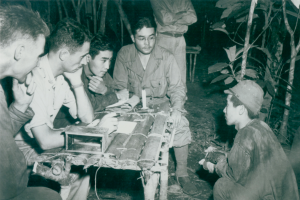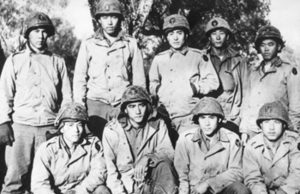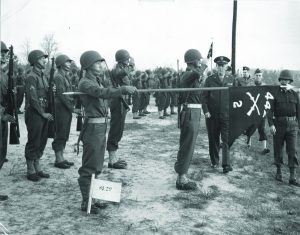History of 442nd Regimental Combat Team
Immediately after Pearl Harbor, Japanese American’s draft status was changed to “4C” – enemy alien not eligible for draft.
Many volunteers were thus denied. Those who were already in military were either discharged or given menial duties.
However, manpower shortage in Hawaii forced Hawaiian National Guard to retain Nisei soldiers.
After the Battle of Midway, June 1942, fear that Japanese American soldiers would side with Japan if Japan invaded Hawaii, the authorities sent the Guard unit to Camp McCoy in Wisconsin. The Nisei of this Guard unit were organized into a separate combat unit: the 100 Infantry Battalion.
Their good training record convinced the War Department to reconsider Nisei’s 4C status. On February 1, 1943, President Roosevelt announced the formation of a segregated Nisei combat team for those who wished to volunteer. The 442nd Regimental Combat Team was born.
While 10,000 volunteered for 3,000 positions in Hawaii, the number of volunteer from the camps on the mainland was understandably smaller. Hence the draft of Nisei began in January 1944.
Volunteers from Hawaii and the mainland began training at Camp Shelby, Mississippi in March 1943.
Meanwhile, the 100th Infantry Battalion was sent into combat in Italy. From September 1943 to June 1944, the 100th Infantry Battalion distinguished itself in numerous battles and impressed the War Department. Its casualty rate resulted in being called the “Purple Heart Battalion.”
In June 1944, the fully trained 442nd Regimental Combat Team arrived in Italy and joined with the battle-tested 100th Infantry Battalion which became the 1st Battalion of the 442nd RCT. However, because of its well-earned reputation, the 100th Infantry Battalion was allowed to keep the original unit designation.
The 442nd RCT’s first major test was to liberate a town called Bruyeres, France. After taking four tactically advantageous hills and the city of Biffontaine, the town of Bruyeres was liberated, unfortunately, with a very high casualty rate.
Two days later, the 442nd RCT was ordered to rescue the 275 men of the 141st Infantry of the 36th Texas Division…the “lost battalion.” It advanced too quickly and was cut off and surrounded by determined German forces ordered by Hitler to decimate the 141st.
After a heroic but costly charge on October 30th, 1944, the lead element of the 442nd RCT finally reached and rescued 211 Texans. Rescue of the “lost battalion” is listed by the US Army as one of the top ten most significant battles in its history. By direction of Governor John Connally in 1960, all men of the 442nd RCT are now honorary citizens of the State of Texas.
Through Bruyeres and rescue of the “lost battalion,” one company had 8 still standing, another 17 of the usual 200-plus unit during a formation ordered by the Division Commander.
In the spring of 1945, the 442nd RCT was back in Italy for the final series of campaign against the Germans who made their final stands.
In April 1945, the 442nd RCT was ordered to take the formidable German position at the Gothic Line that the 92nd Infantry Division had been unable to penetrate for six months.
Three Companies of the 442nd RCT directly climbed the steep, 3,000 ft mountain fortress (Mt Folgorito) at night. It took them 8 hours, but at dawn, they surprised the Germans at the top. The Gothic Line was broken in mere 34 minutes.
The 522 Field Artillery Battalion of the 442nd RCT was detached after liberation of Bruyeres and the rescue of the “lost battalion.” They were attached to various units in Germany, and the lead scout of the 522nd was one of the first to reach and liberate the Dachau concentration camp. Irony was that the family members of many of the 522nd soldiers were still confined in relocation camps in their own country.
The 442nd RCT became the most decorated unit in the history of the US Army for its size (regiment) and the duration of service (1943-1945). It produced 21 Medal of Honor recipients.
Why were they so heroic with its battle cry: “Go For Broke”? One Medal of Honor recipient summed it up when he said, “We had to prove our loyalty to the United States.”
Credit: Multiple sources




